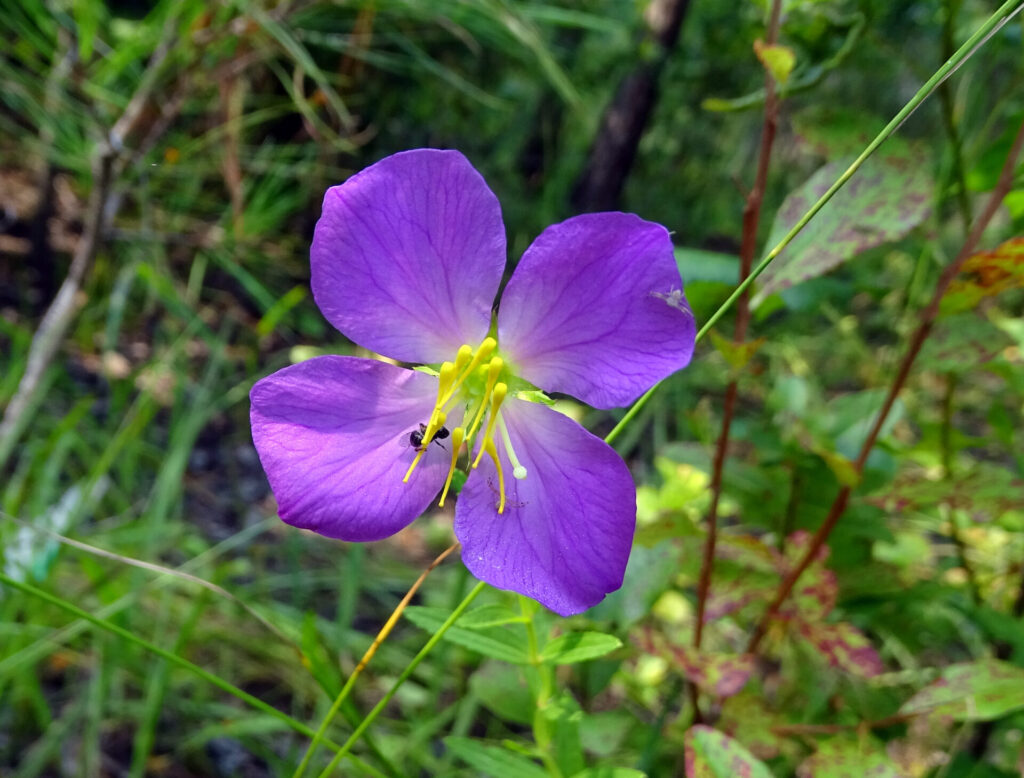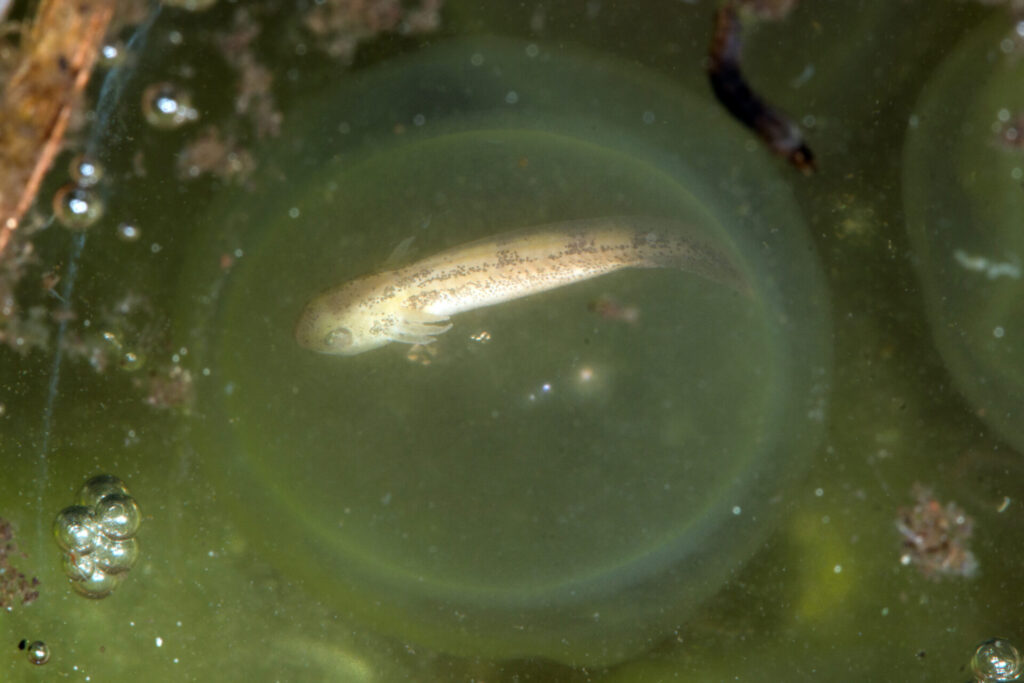By Natural Heritage Program biologists and staff
Cypress Savannas might be the most charismatic natural community in North Carolina that you have never heard of, and as a result, might not fully appreciate. Your first impression might be awe of the natural beauty of the Pond Cypress (Taxodium ascendens) contrasting against the surrounding landscape of farmland or pine trees, but a deeper understanding reveals their importance as a habitat.
A natural community is defined as a distinct and reoccurring assemblage of populations of plants, animals, bacteria, and fungi naturally associated with each other and their physical environment. Natural communities can be recognized as distinct forest, rock outcrop, woodland, or wetland types and are significant in that they represent predictable associations of plants and animals that occur across the landscape. The North Carolina Natural Heritage Program (NHP) gathers and shares information about rare species and natural communities to ensure public access to information that is needed to weigh the ecological significance of natural areas and to evaluate potential impacts of conservation and development projects. NHP provides information that facilitates ecologically sound development and infrastructure projects, such as pipeline corridors, roads, communication towers, and municipal utility projects.

The natural communities in this article are described based on the Classification of the Natural Communities of North Carolina (Fourth Approximation) (Schafale in prep. 2023)1. The Natural Heritage Program promotes the protection of the most intact, highest quality natural communities, and the presence of natural communities is a key component in the identification and assessment of natural areas. Study and analysis of natural communities helps guide restoration of degraded landscapes. In summary, mapping and tracking of communities is essential to support conservation, restoration, and management of natural areas and the unique features that they contain.
A visit can be a challenge
There are several reasons Cypress Savannas are not well known, including that they tend to be wet, and therefore can be challenging to visit. Surface water typically persists well into the growing season but disappears due to transpiration and evaporation before the end of summer in ordinary years. However, water levels and hydroperiods vary substantially in response to weather cycles, which can last for months, or even years. Carolina bays generally have little local watershed, so most of the water that floods them may come from rainfall. It is not well known how closely the hydrology of these depressions is linked to groundwater. Because they have an impermeable clay layer, water presumably is perched when the water table is low, even if it is connected to the water table at wetter times. The hydroperiod is too short to support floating or emergent aquatic plants on a long-term basis, and too wet to support trees other than Pond Cypress and Swamp Tupelo (Nyssa biflora) long-term under natural conditions.
Cypress Savannas occur in Coastal Plain depressions – relatively small, closed basins that hold standing water at least at times; while they usually occur in clay-based Carolina bays, these habitats can occasionally be found in other flat outer Coastal Plain depressions.
Herb layer varies over time

One of the interesting features of Cypress Savannas is the vegetation in the herb layer. If the Cypress Savanna community is in its natural condition, it contains a dense herb layer that often varies year to year with changing water levels, and an open tree canopy of Pond Cypress (Taxodium ascendens); however, trees may be absent. The vegetative changes are more likely to appear as complete changes in dominant species — a biologist making repeated visits to a Cypress Savanna should not be terribly surprised to observe the herb layer dominated by one or two species one year, then find a different species composition on subsequent visits a couple of years later. Long-lived seed banks are extremely important in Cypress Savannas, apparently more so than in any other community in North Carolina. Species unseen for years may abruptly reappear in abundance when conditions change, and such species have at times been found in dormant seed banks (Kirkman and Sharitz 1994)2
Perhaps one of the more surprising aspects of Cypress Savannas is that fire appears to be an important process. Fire was the likely natural mechanism keeping Loblolly Pine (Pinus taeda) and Sweetgum (Liquidambar styraciflua) from invading the depressions in dry periods, and subsequently persisting. The woody vegetation of Cypress Savannas is necessarily more stable than the herb layer. While Pond Cypress trees are not usually large, they may be old. Mature trees are tolerant of fire and could readily survive dry periods. Opportunities for Pond Cypress reproduction may be limited, leading to an age structure with only a few widely separated cohorts. Observations of older aerial photography suggest that tree density and cover often is stable over decades, and alterations in the tree component can also be stable (i.e., persist over a long period of time) — examples with old stumps but no trees can be observed. Many managers of Cypress Savannas are working to restore growing-season fire (i.e., when the wetlands are dry) to these habitats.
Typic and Acidic Types of Cypress Savannas
Michael Schafale considers two types of Cypress Savannas – Typic and Acidic. The Acidic Subtype covers Cypress Savannas with vegetation that is dominated by acid-loving or boggy plants such as Virginia Chain-fern (Anchistea (Woodwardia) virginica), Walter’s Sedge (Carex striata), and peatmoss (Sphagnum spp.) and is generally relatively low in species richness. It is unclear if sites of the Acidic Subtype were initially more acidic or became so because of the vegetation.

The Typic Subtype covers examples with diverse herb layers of species typical of Coastal Plain mineral soils. The herb layer is dense and often diverse when water levels are down. The meadow-like aspect of the Cypress Savanna is provided by grasses and sedges such as Wright’s Witchgrass (Dichanthelium wrightianum), Netted Nutrush (Scleria reticularis), Muehlenberg’s Nutrush (Scleria muhlenbergii), Narrow-fruit Horned Beaksedge (Rhynchospora inundata), Warty Panicgrass (Kellochloa (Panicum) verrucosa), Three-angle Spikerush (Eleocharis tricostata) and are then typically punctuated with colorful flowers of Awned Meadow-beauty (Rhexia aristosa), White-bracted Thoroughwort (Eupatorium leucolepis), Bay Boneset (Eupatorium paludicola), Rosy Camphorweed (Pluchea baccharis), or White Doll’s-daisy (Boltonia asteroides).Awned meadow-beauty is a delight to see in bloom in late summer and is rare throughout its coastal plain range. Boggy species such as Virginia Chain-fern and Walter’s Sedge may be present but are not strongly dominant. The Typic Subtype generally supports a diverse mixture of plants that emerge when water goes down and those that grow in the water, but the vegetation may vary drastically from year to year. The name of the Acidic Subtype is meant to convey the bog-like extremely acidic conditions suggested by the species composition and abundance of Sphagnum. However, the Typic Subtype, too, has acidic soils.

Like other small Coastal Plain depression communities, Cypress Savannas are important to amphibians, and might include breeding habitats for both rare and common species. Many of our rare, isolated wetland breeding amphibians such as Tiger Salamanders (Ambystoma tigrinum), Oak Toads (Anaxyrus quercicus), and Southern Chorus Frog (Pseudacris nigrita), and even some reptiles like the Chicken Turtle (Deirochelys reticularia) readily use seasonally flooded Cypress Savannas.
NHP currently includes seven examples of the Acidic Subtype and twenty-three examples of the Typic Subtype in North Carolina in our database. For more information about natural communities in North Carolina, visit https://www.ncnhp.org/references/publications/guide-classification-natural-communities-north-carolina-4th-approximation
Many Cypress Savannas are located on private land, and a few are on military installations. Examples on public land that can be generally visited are located in Bladen Lakes State Forest and Sandhills Game Land. Other opportunities to visit Cypress Savanna may be available through field trips organized by The Nature Conservancy or NC Plant Conservation Preserves to preserves.
1Schafale, M.P. 2023 in prep. Classification of the Natural Communities of North Carolina. Fourth Approximation. North Carolina Natural Heritage Program, Department of Natural and Cultural Resources, Raleigh.
2Kirkman, L.K. and R.R. Sharitz. 1994. Vegetation disturbance and maintenance of diversity in intermittently flooded Carolina bays in South Carolina. Ecological Applications 4:177–188.
To read more about Natural Communities in NC:
David Blevins and Michael Schafale. 2011. Wild North Carolina.
https://uncpress.org/book/9780807834671/wild-north-carolina/
B.W. Wells. Revised edition 2002. The Natural Gardens of North Carolina.
https://uncpress.org/book/9780807849934/the-natural-gardens-of-north-carolina/
By Natural Heritage Program biologists and staff
Native Plant News – Winter 2023
Author Bios: Natural Heritage Program biologists and staff are recognized for their decades of field experience and are dedicated to the conservation and protection of North Carolina’s rich natural heritage. You can find contact information for us on our website here https://www.ncnhp.org/contact.
Editor’s Note: For more on wetlands, read “Who Cares About Wetlands?,” exploring recent North Carolina legislation and how it impacts our wetlands, in NC Native Plant News Winter 2023.

